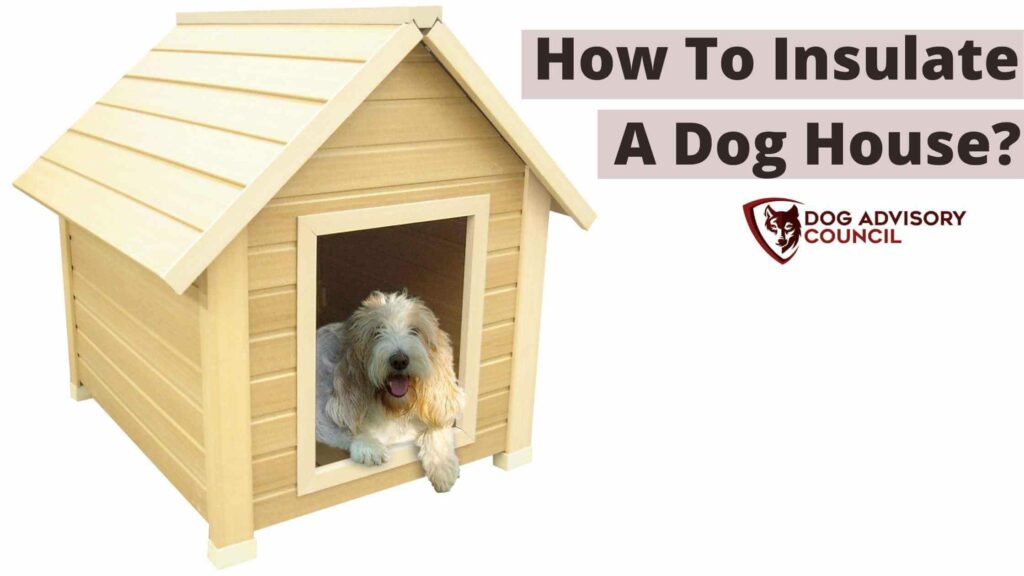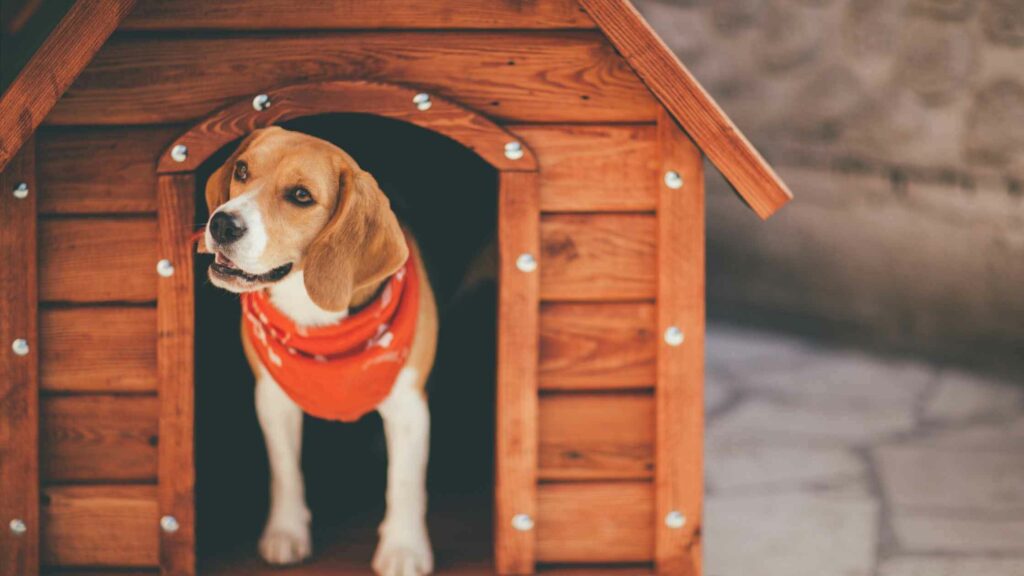
You want to make sure that your dog has comfort all year-round. This means that you’ll need to get familiar with dog house insulation! Here’s what you need to know on how to insulate a dog house!
Insulating a doghouse starts with figuring out what type of insulation you want to use. Your options include fiberglass, reflective foil, specialized bubble wrap, polystyrene foam, expanding spray foam, wood, and water. You’ll also want to consider both cold weather and warm weather insulation. Learn all about the process below!
Should I insulate my dog house?
If you intend on allowing your dog to rely on their dog house outside during the cold or warm months. In that case, insulation is something that you definitely need to put in place. Insulation regulates the temperature in the dog house so that your dog won’t need to worry about fluctuations in temperature as the outside temperature soars or plummets.
This fluctuation is not only uncomfortable, but it also could be dangerous to your dog’s health. An insulated dog house is something that some think is “above and beyond” what a dog should need, but your dog’s comfort and safety shouldn’t be left to chance.
If they don’t have an insulated dog house, make sure that they have a way to come inside your house as needed, when needed!
How warm is an insulated dog house?
Generally, a dog house will be 10-20 degrees warmer/cooler than the ambient temperature. When it comes to warding off the chill or beating the heat, that’s a huge difference! You might think it wouldn’t make a difference if it’s scorching hot or freezing cold outside, and you’d be right!
But remember that a dog house is not meant to be like a human’s home. That is, dogs shouldn’t be left to fend for themselves in an insulated dog house during heat waves or deep freezes! An insulated dog house is meant to help keep them more comfortable as the temperature shifts.
What can I put in a dog house to keep it warm?
When you’re looking specifically at keeping your dog house warm with insulation, you’ll want to focus on the following options for the best temperature-beating options:
- Fiberglass
- Reflective foil
- Specialized bubble wrap
- Polystyrene foam
- Expanding spray foam
- Carpet
- Wood
- Water
Fiberglass
This is the pink stuff that you use in modern homes. It looks like cotton candy. It can be used in a dog house for insulation and has an excellent R-value (the number used to determine the insulation’s effectiveness). It is affordable, easy to install in your dog house, and cozy, so your dog will feel nice and snuggly.
Reflective foil
This thin foil reflects your dog’s body heat right back to them. This foil is often used in self-warming dog beds. It is easy to install in your dog house, doesn’t need to be covered, and works well for helping your dog stay comfortable in the weather extremes.
Specialized bubble wrap
This isn’t quite like the normal bubble wrap used for packing and crafts, but it’s very similar! It has a thin layer of reflective foil that will work with the bubbles to reflect your dog’s body heat back at him, similar to the one above. This is always a bit more expensive, but it’s an excellent choice for effectiveness.
Polystyrene foam
This is a classic option that is readily available. It’s cheap, and you can get it in sheets, balls, and more. It will take up more space than other methods, and it will also be difficult to work with because it’s not the strongest, best quality material!
Expanding spray foam
This is an expensive option for insulating a dog house but an excellent idea for when you are looking for something effective. You just spray it over the walls and ceiling, and it’ll expand over the space and create an even heat retention.
Carpet
Carpet is expensive if you buy it new, but you can get it second-hand. Get indoor carpet, as it holds the heat better. You would staple this over the walls and ceiling, and it’ll help retain heat. It’s cheap but not great for cutting out many weather shifts. It simply “takes the edge off.”
Wood
This is also not the most effective at insulating your dog house, and it requires experience and expertise to properly install in your dog house. To get the best R-value, you’ll want to install it with a gap between the external and internal walls. You’ll also want to water seal it for the best insulation value!
Water
This is cheap but certainly a challenging option! You’ll fill water bottles and then install them around the dog house at even intervals! The water will hold the warmth and keep the chill out.
There’s going to be a lot of time spent on making sure that you get the placement just right, of course, and it’s going to be an adventure as to how to mount them to vertical surfaces. However, it’s a great adventure to explore when you want to think outside the box!
Remember that many insulation types need to be covered, so your dog doesn’t eat them. You’ll have to cover fiberglass, all types of foam, and even the reflective foil and bubble wrap. You can leave the wood and the carpet available, as they often won’t chew on that.
Insulation is dangerous for your dog; they eat all sorts of things they’re not supposed to, so don’t take any chances!

Some sneaky dog house insulation tips
While the focus of this is, of course, to learn how to insulate your dog house’s walls, you also won’t want to forget about the floor! The floor often seeps the warmth out of things, meaning that you’ll need to add some insulation of some type there!
One of the best things you can do is to put the dog house off the ground a bit since the dampness is a huge part of the cold seepage. You also can put down some carpet, newspaper, or a store-bought specially designed insulated dog bed to help literally insulate the floor. These are great for senior dogs that need a bit of extra comfort when they lie in their dog house, too
The other thing to remember with your dog house’s insulation is that you can have the best insulation in the world, and it’ll still be dwarfed by a cold draft! You’ll want to have a good-quality insulated dog flap or door that will keep the draft and elements outside of your dog house.
Best way to insulate a dog house
When you are looking to insulate a dog house, your focus is on doing it in the best way — for you. Everyone’s needs and preferences are different, so everyone’s “best” will be different!
If you want the easiest option for insulation in your dog house, you’ll want to go with fiberglass. You don’t need any specialized tools to work on it, and it’s easy to install.
If you’re looking for the most unique option to insulate your dog house, you can look at the water bottles. They’ll be cost-effective in that it’s just water bottles, but some work goes into setting them up to actually serve as insulation!
If you want the easiest option as far as stress, you can try a “one-and-done” approach with a pre-built insulated dog house! They are a bit pricey, though they’re lower now than they used to be, but you won’t need to DIY anything!
How do you insulate a dog house in the summer to keep it cool?
Insulation is as crucial in the summer as in the winter, as we discussed above. So, do you have to tear out your insulation twice a year to switch it to the most effective insulation for the summer? Nope! Your insulation will be safe and effective for the summer season, too!
The main difference you’ll want to consider for summertime is adding airflow. Add in a fan or something else that will help keep air circulating.
Is straw a good insulator for a dog house?
While some use straw as an insulator for a dog house, it’s not the most effective choice. Not only will it be a prime location for pests such as bugs and mice to nest, but it also can get wet and ruined easily and isn’t a great insulator for temperature regulation.
Conclusion
Insulating a dog house for your furry friend’s enjoyment is a great way to help them get a little bit more enjoyment out of it as the weather changes, and it helps you to know that they have access to a protected and weather-safe space.
Your options on insulation include fiberglass, reflective foil, specialized bubble wrap, polystyrene foam, expanding spray foam, wood, and water. Make sure that you remember to add an insulated door and insulate the floor in some way that is comfortable for your dog and effective for their comfort.
Remember that an insulated dog house is safe for weather changes, but not for weather extremes! Know someone who wants to take on this challenge? Share this article with them!
